


Framed or unframed, desk size to sofa size, printed by us in Arizona and Alabama since 2007. Explore now.
Shorpy is funded by you. Patreon contributors get an ad-free experience.
Learn more.

- Freeze Frame
- Texas Flyer wanted
- Just a Year Too Soon
- WWII -- Replacing men with women at the railroad crossing.
- Yes, Icing
- You kids drive me nuts!
- NOT An Easy Job
- I wonder
- Just add window boxes
- Icing Platform?
- Indiana Harbor Belt abides
- Freezing haze
- Corrections (for those who care)
- C&NW at Nelson
- Fallen Flags
- A dangerous job made worse
- Water Stop
- Passenger trains have right of way over freights?
- Coal
- Never ceases to amaze me.
- Still chuggin' (in model form)
- Great shot
- Westerly Breeze
- For the men, a trapeze
- Tickled
- Sense of loneliness ...
- 2 cents
- Charm City
- What an Outrage
- Brighton Park
Print Emporium
Point Bridge: 1900
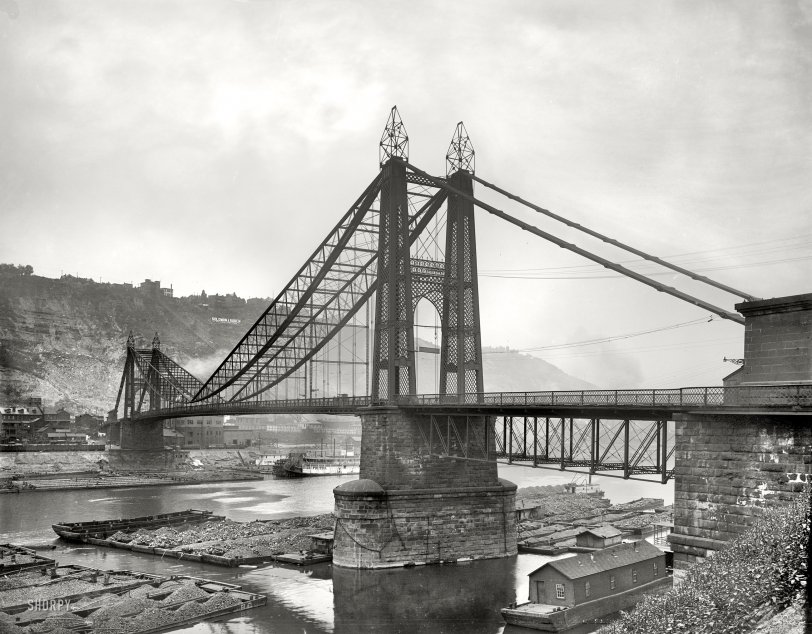
Pittsburgh circa 1900. "Point Bridge and coal barges." Note the Duquesne Incline railway next to the Solomon & Ruben sign. 8x10 glass negative. View full size.
+111
Below is the same view from July of 2011.
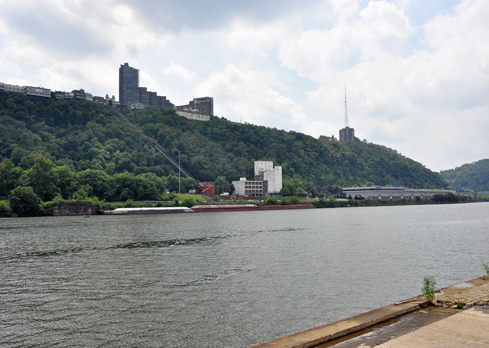
Current Crossing
To add to what Larc mentioned, the Fort Pitt Bridge replaced the (new) Point Bridge in 1970.
Stiffened Chain Suspension
Transactions of the American Society of Civil Engineers,
Vol VII., 1878.Bridge Superstructure.
Subjects Exhibited.
Point Bridge was designed by Edward Hemberle, Engineer of the American Bridge Company. It consists of tower and chains, with platform suspended therefrom in the same manner as in a regular chain suspension bridge. To this is added a stiffening system above the chains, and rigid posts arranged between chains and platform so as to prevent the roadway from undulating or oscillating independently of the structure above. The stiffening appliances above the chains consist of rigid chords running in straight lines from the top of the tower toward the center of the chain, and connecting thereto by a hinged joint at each end. Between these chords and the chains there is a system of bracing, composed of posts and diagonal tie-rods, all connections being pin-jointed. The chain, being a catenary, or curve of equilibrium, bears all the permanent load of the structure without straining the stiffening trusses. This object was accomplished by erecting the bridge completely before connecting the ends of the straight top chords to the centre joint. The rods are provided with turn-buckles, and are so adjusted as to be strained under moving loads only.
The total length of the bridge is 1,245 feet from back to back of anchorages, with one middle span of 800 feet between centres of piers, and one independent trussed side span of 145 feet in length at each shore. The roadway rises from both shores toward the centre of the channel, with grades not exceeding 3½ feet in 100 —the highest point of the roadway being 83 feet above low water. The saddles upon which the chains rest on top of the towers are 180 feet above low water. The deflection of the chain is 88 feet, which is considerably more than is usual for suspension bridges, but the stiffening allows of increasing the deflection and thereby reducing the strains in the chains as well as their weight. The bridge is 34 feet wide from centre to centre of outside railings, and this space is divided into a roadway 21 feet wide and two sidewalks of 6½ feet each.
History of Bridge Engineering,
By Henry Grattan Tyrrell, 1911.Chapter XII.
Suspension Bridges.
311. The Point bridge (Fig. 115) at Pittsburg was designed by Edward Hemberle, and built in 1876 with a center span of 800 feet and two side spans of 145 feet each, making a total length of 1,250 feet. It had a 20-foot roadway and two 7-foot walks with a clear height beneath of 80 feet and cost $525,000. The river piers were of stone and the towers of iron, 110 feet high. The 8-inch eyebar cables have stiffening trusses above the chains in the form of segmental chords, and the design is such that all uniform loads are carried by the cables, causing no stress in the stiffening trusses. It was the longest span with flat eyebars in America, and toll was collected upon it till 1896. In 1906 it was repaired at a cost of $92,000.
Bridge speed limit
DRIVE NO faster than A WALK
UNDER PENALTY of the LAW
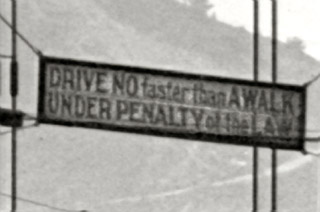
145 Years Earlier
I just got done researching the heck out of this very spot for a drawing. Amazing how fast things change. For your enjoyment: Fort Duquesne on July 9, 1755, the day of Braddock's Defeat.
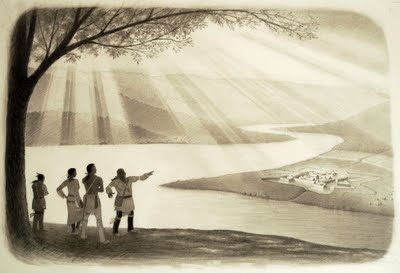
Looks like a color picture to me
Given all the coal and its widespread use at the time the picture was taken, I don't think a color picture (if it were available then) would look much different. At least in those days times were simpler in that it was common to look at things as being either black or white.
Location, Location, Location
I think, "Solomon & Ruben, Reliable Clothiers" could have been to Pittsburgh what the "HOLLYWOOD" sign was to Los Angeles. Talk about placement.
On the edge
Watch that first step, it's a doozie!! Hope no sleepwalkers lived in those buildings up there!
The old Point Bridge is gone
Built in 1877, it was replaced in 1927. The replacement was closed in 1959 and demolished in 1970. But the Duquesne Incline is still there and is still in operation.
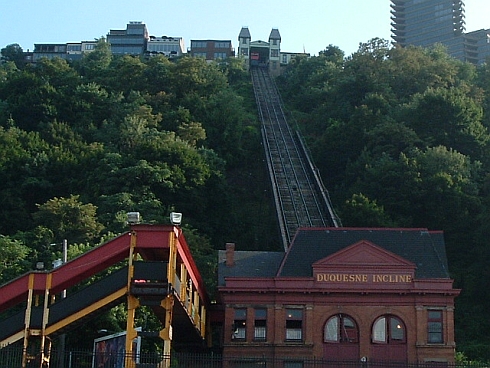
Duquesne Incline Station
Here's another view of the incline's upper station. It's the frame building behind the streetcar. This photo was taken on Grandview Ave about 1920. The streetcar's destination number was "40 Mt. Washington".
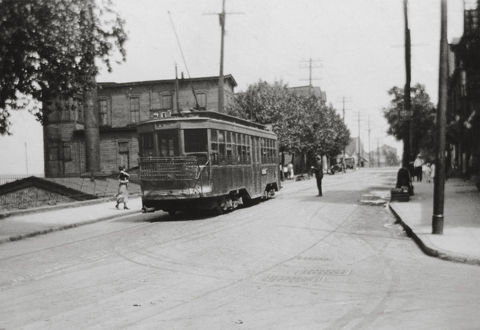
























On Shorpy:
Today’s Top 5